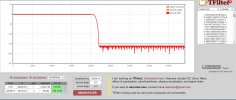-b74 itself does not have any inherent quality meaning. To begin with, you used "rate -uL -b74". Now -u and -v have a meaning of quality: -u has higher noise attenuaton than -v, but as you can see it is already bottlenecked by the 24-bit quantization limit. "L" means linear phase, but by default SoX use linear phase, so it is redundant. -b74 is not an additonal step as SoX by default uses -b95, so there is no extra processing. Therefore you can see that I originally use -vb74.
It really depends on what you considered as important. For example, the reason I used the Mahler file among others is mainly because it has some high frequency content blended with the rising DSD noise, while other files essentially have no musical content above 20kHz, so it makes no sense to even use 88.2k target.
If you are doing batch conversion without inspecting every single file, and consider these ultrasonic musical content as important in the sense of archiving, -vb74 will give some leeway about these uncertainties if you leave some frequency headroom. If you are really afraid of noise, you can trim it in real time during playback with appropriate plugins. On the other hand, if you cut too much on the converted flac files, you can't really boost the lost frequency. Also, since it is a forum thread, everyone can read it and different people have different opinions, some may think that leaving it as is (-b95) is the way to go as well, so I can't be so specific about what is "the best".



